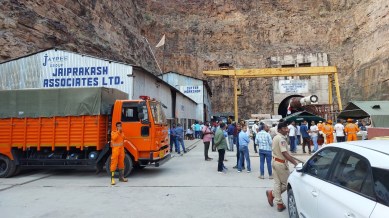Express Exclusive: 5 years before Telangana tunnel collapse, report warned contractor of weak rocks and water retention
8 men were trapped in the tunnel on February 22. Rescuers are yet to reach them

Five years before a part of the SLBC Tunnel in Telangana collapsed, trapping eight men on February 22 this year, a report commissioned by Jaiprakash Associates Ltd warned of a possible “fault zone” in the tunnel — stretches where the possibility of collapse is high.
Jaiprakash Associates Ltd is the Noida-based company that was awarded the tunnelling contract in 2005.
When contacted, Jaiprakash Associates Ltd confirmed the report but refused to elaborate, saying, “We have no comments on this.” Amberg also declined to comment, stating that the report and its data are confidential.
The company calculated the risk by transmitting seismic waves into the rock mass and recording and evaluating the portions with anomalies. The remarks in the report read, “Decrease in rock stiffness”, “possible jointed sheared rock mass”, and “possible water bearing zone”.
Rescuers in the know said the collapse happened near this stretch. “The roof caved for three metres around the fault zone,” a top official involved in the rescue operations said.
The rescue operations have had to be intermittently stopped because the tunnel keeps flooding, and search and rescue operations are going on after 13.5 km into the tunnel, a rescuer said. Here, the tunnel boring machine is stuck at a dead-end, and the workers are nowhere in sight, the official said.
The report was submitted to Jaiprakash Associates Ltd in 2020, it is learnt. “It is not known whether this report was shared with the Irrigation Department of the state government,” a source said.
When contacted, a top official from the Irrigation department, who worked on the SLBC project, told The Indian Express, “I do not recollect having gone through this report.”
Asked whether the conditions on the ground could change in four years, a geologist said, “In four years, the ground condition would remain the same — that is, the rocks would remain the same. But there could be more chances of water seepage.”
Meanwhile, another study on the tunnel had revealed a different anomaly, again in 2020. As per a research paper by former Director General of Geological Survey of India Mandapalli Raju and Jaiprakash Associate’s geologist Rituraj Deshmukh, the tunnelling started with poor subsurface exploration.
The paper, Geotechnical aspects of a long tunnel, driven by TBM at SLBC of AMR Project, Telangana State, India, reads, “As the entire tunnel alignment falls in Tiger Reserve Forest, subsurface investigations such as drilling boreholes or excavation of drifts along the tunnel alignment were not permitted. Further, most of the tunnel alignment is inaccessible for physical examination. As a result, excavation of the tunnel was commenced without any firm and confirmed geotechnical data.”
Tunnelling started with a “broad preliminary assessment of the terrain” based on “the data available and experience gained in tunnels of Srisailam Left Bank Underground Power Station present in the vicinity, and taking help of aerial photo study and using remote sensing techniques”, the paper read.
Those feared dead in the tunnel have been identified as Sunny Singh and Gurpreet Singh of Robbins Tunnel Boring Machines Manufacturing Company, and Manoj Kumar, Srinivas, Sandeep Sahu, Santosh Sahu, Anuj Sahu and Jagath Khes of Jaiprakash Associates Ltd.